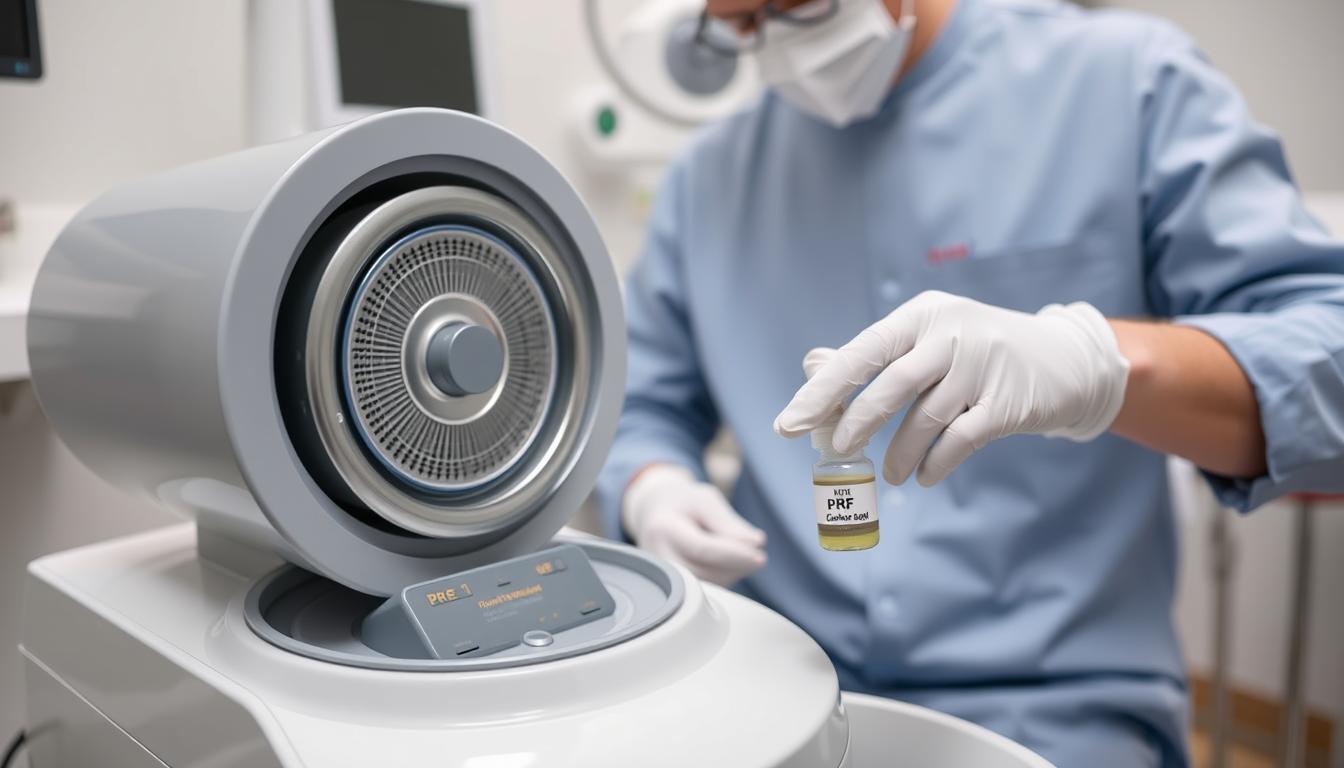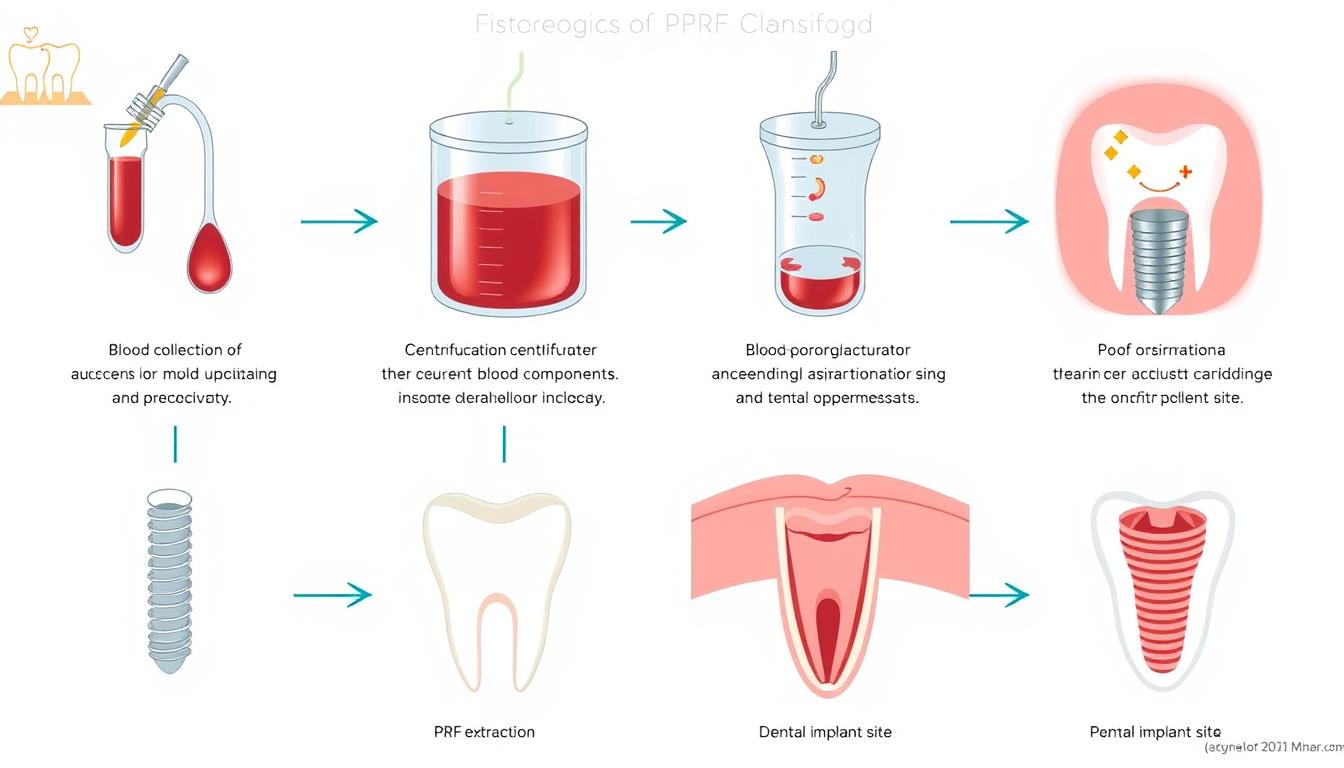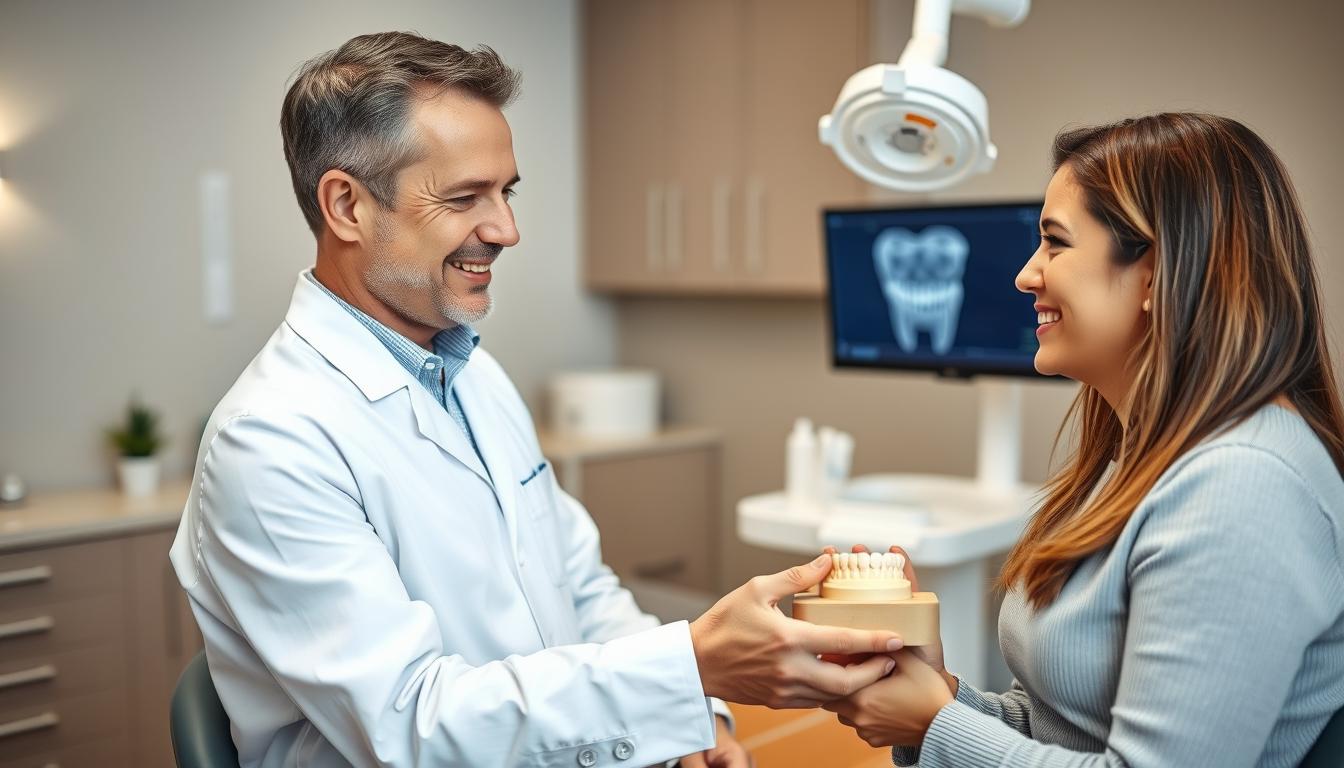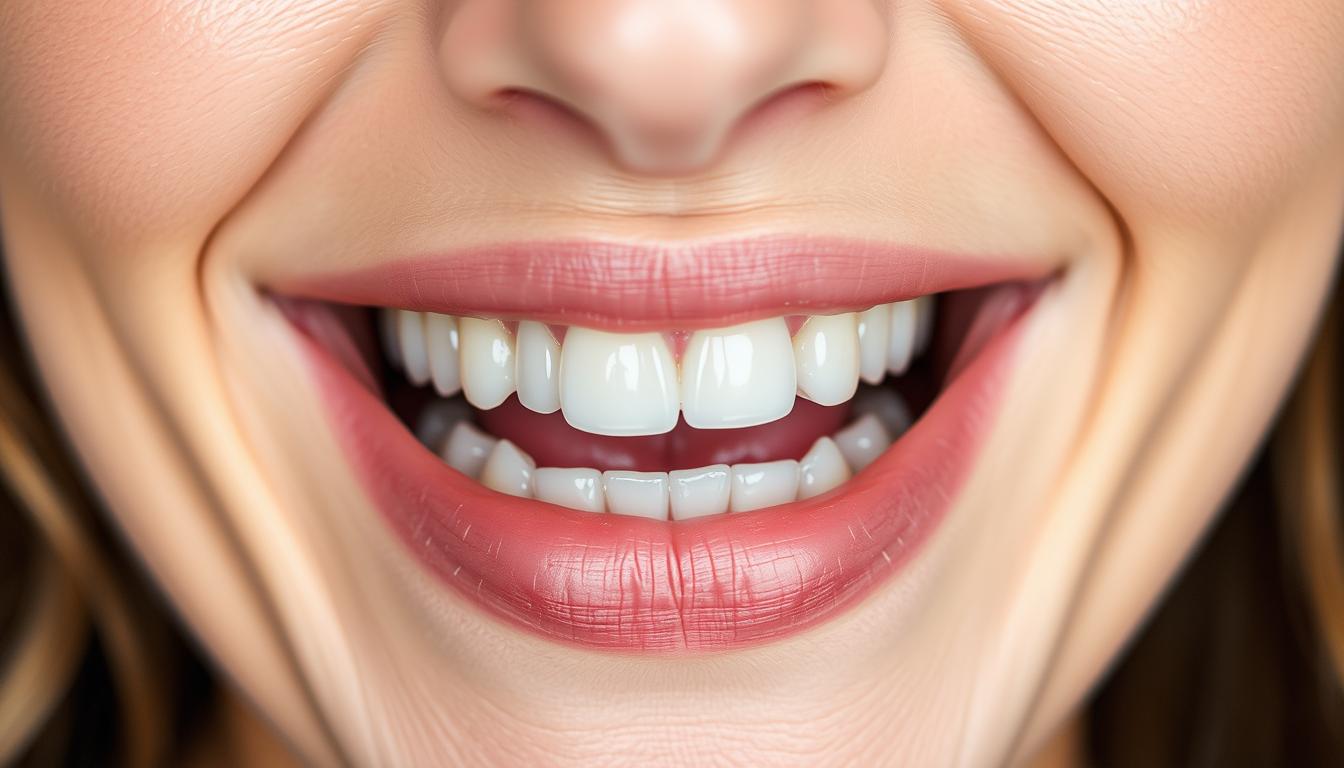Think of PRF treatment for dental implants as your body’s own healing accelerator. When getting dental implants, your recovery time and success rate can be significantly improved with this innovative approach. Platelet-Rich Fibrin (PRF) therapy harnesses your body’s natural healing abilities to create stronger implant foundations and faster recovery—like having a specialized team of microscopic healers working around the clock at the implant site.

What Is Platelet-Rich Fibrin (PRF) Treatment?
Platelet-Rich Fibrin is a concentrated form of your own blood that contains powerful growth factors and healing proteins. Unlike artificial healing aids, PRF is 100% natural—it comes directly from your own body, eliminating any risk of rejection or allergic reaction.
When applied during dental implant procedures, PRF creates a natural scaffold that accelerates tissue regeneration and bone formation around the implant. This natural approach enhances the integration between your jawbone and the titanium implant, creating a stronger foundation for your replacement teeth. PRP Treatment for Dental Implants: Benefits, Procedure, and Effectiveness

Is PRF Treatment Safe?
PRF therapy is exceptionally safe because it uses your own blood components. There’s virtually no risk of disease transmission or allergic reactions since no foreign substances are introduced. The procedure is minimally invasive, requiring only a simple blood draw similar to routine lab work.
5 Key Benefits of PRF Treatment for Dental Implants
PRF therapy offers significant advantages when incorporated into dental implant procedures. These benefits directly address the most common concerns patients have about implant surgery.
- Accelerated Healing: PRF releases growth factors that speed up tissue regeneration, reducing overall recovery time by up to 50% compared to traditional methods.
- Reduced Infection Risk: The concentrated white blood cells in PRF provide natural antibacterial properties that help protect the surgical site from infection.
- Minimized Pain and Swelling: Patients typically experience less post-operative discomfort and inflammation when PRF is used during implant placement.
- Enhanced Bone Integration: PRF promotes faster and stronger osseointegration—the critical process where bone fuses with the implant surface.
- Improved Soft Tissue Healing: The fibrin matrix in PRF supports better gum tissue healing around the implant, creating more natural-looking results.

Wondering if PRF treatment is right for your dental implants?
Schedule a consultation with an implant specialist to discuss how PRF therapy can improve your treatment outcomes.Request a Consultation
The PRF Treatment Procedure for Dental Implants
Understanding the step-by-step process of PRF therapy can help ease concerns about this innovative treatment. The entire procedure is straightforward and typically adds minimal time to your dental implant appointment.
- Blood Collection: A small amount of your blood (usually 2-4 tubes) is drawn from your arm, similar to a routine blood test.
- Centrifugation: Your blood sample is placed in a specialized centrifuge machine that spins at a precise speed for about 12 minutes.
- Separation: This spinning process separates your blood into distinct layers, with the middle layer containing the valuable PRF.
- PRF Extraction: The dentist carefully extracts the PRF layer, which has a gel-like consistency rich in platelets, white blood cells, and growth factors.
- Preparation: The PRF is prepared into either a membrane or a plug, depending on how it will be used during your implant procedure.
- Application: During implant placement, the PRF is applied directly to the surgical site, surrounding the implant and filling any gaps in the bone.

“The beauty of PRF therapy lies in its simplicity and effectiveness. We’re essentially concentrating your body’s own healing factors and applying them exactly where they’re needed most.”
— Dr. James Richardson, Implant Specialist
PRF Treatment vs. Traditional Bone Grafting Methods
When comparing PRF therapy to conventional approaches for dental implant procedures, several key differences become apparent. Understanding these distinctions can help you make an informed decision about your treatment options.
| Factor | PRF Treatment | Traditional Methods |
| Source Material | Patient’s own blood (autologous) | Animal, synthetic, or cadaver bone |
| Biocompatibility | 100% compatible (no rejection risk) | Potential for rejection or reaction |
| Healing Time | Accelerated (3-4 months average) | Standard (5-6 months average) |
| Pain & Swelling | Minimized | Moderate to significant |
| Infection Risk | Lower (contains white blood cells) | Standard |
| Additional Procedures | Simple blood draw | May require donor site surgery |

Are You a Candidate for PRF Treatment with Dental Implants?
While PRF therapy is beneficial for most dental implant patients, understanding if you’re an ideal candidate can help set appropriate expectations for your treatment outcomes.
Ideal Candidates Include:
- Patients with adequate blood clotting function
- Those needing single or multiple dental implants
- Patients with moderate bone loss requiring augmentation
- Individuals concerned about healing time
- Those with health conditions that may affect healing
PRF May Not Be Suitable For:
- Patients with severe blood disorders
- Those taking high-dose blood thinners
- Individuals with certain autoimmune conditions
- Patients with active cancer undergoing treatment
- Those with severe platelet dysfunction

Important: Only a qualified dental professional can determine if PRF treatment is appropriate for your specific case. A comprehensive evaluation is necessary to assess your oral health, medical history, and treatment goals.
Recovery Timeline After PRF Treatment for Dental Implants
One of the most significant advantages of PRF therapy is its ability to accelerate the healing process after dental implant placement. Here’s what you can typically expect during your recovery period.
First 24-48 Hours
With PRF treatment, initial healing begins immediately. The fibrin matrix forms a protective seal over the surgical site, minimizing bleeding and swelling. You may experience mild discomfort, but it’s typically less intense than with traditional implant procedures.
What to expect: Minimal bleeding, reduced swelling, and manageable discomfort that responds well to over-the-counter pain relievers.
First Week
The growth factors in PRF continue working to accelerate soft tissue healing. Most patients notice significantly less swelling and discomfort by day 3-4, compared to 5-7 days with conventional approaches.
What to expect: Rapid reduction in swelling, minimal discomfort, and visible improvement in the appearance of the surgical site.
Weeks 2-4
Soft tissue healing is substantially complete, with the implant site appearing much more natural. The PRF continues to support bone regeneration around the implant fixture.
What to expect: Normal appearance of gum tissue, minimal to no discomfort, and ability to resume normal diet with caution around the implant site.
Months 2-3
This is where PRF treatment really shines. Osseointegration (bone fusion with the implant) progresses more rapidly than with traditional methods. Many patients are ready for the final restoration 1-2 months earlier than the standard timeline.
What to expect: Stable implant with good initial integration, potential for earlier restoration depending on your specific case.

Call (800) 123-4567 for a PRF consultation
Post-Treatment Care for Optimal Results
While PRF treatment accelerates healing, proper aftercare remains essential for achieving the best possible outcomes with your dental implants.
Do’s:
- Follow all post-operative instructions provided by your dentist
- Take prescribed medications as directed
- Use cold compresses during the first 24 hours to minimize swelling
- Maintain excellent oral hygiene, carefully brushing around the implant site
- Eat soft foods for the first few days
- Attend all follow-up appointments to monitor healing progress
Don’ts:
- Smoke or use tobacco products (severely impairs healing)
- Drink through straws during the first 48 hours
- Exercise vigorously for at least 3-4 days after surgery
- Probe the surgical site with your tongue or fingers
- Skip follow-up appointments, even if feeling fine
- Resume normal chewing on the implant site until cleared by your dentist

Nutrition Tip: A diet rich in protein, vitamin C, and zinc can further support your body’s healing process after PRF treatment. Consider incorporating foods like eggs, fish, citrus fruits, nuts, and leafy greens to complement the regenerative effects of PRF therapy.
Frequently Asked Questions About PRF Treatment for Dental Implants
Does PRF treatment hurt?
The PRF collection process involves a simple blood draw, similar to what you’d experience during routine lab work. The application of PRF during implant surgery doesn’t cause any additional discomfort, as it’s done while you’re already under local anesthesia or sedation for the implant procedure.
How much does PRF treatment cost?
PRF therapy typically adds between $200-$500 to the cost of a dental implant procedure, depending on the complexity of your case and geographic location. Many patients find this additional investment worthwhile given the improved healing outcomes and potentially shorter treatment timeline.
Is PRF treatment covered by insurance?
Coverage varies by provider. Some dental insurance plans may cover a portion of PRF therapy when used with dental implants, particularly if it’s deemed medically necessary for successful treatment. Check with your insurance provider and dental office for specific coverage details.
Can PRF be used for all types of dental implants?
Yes, PRF can be beneficial for virtually all types of dental implant procedures, including single-tooth replacements, multiple implants, and full-arch restorations. It’s particularly valuable in cases with compromised bone quality or when faster healing is desired.

Is PRF Treatment Right for Your Dental Implant Journey?
PRF treatment for dental implants represents a significant advancement in implant dentistry, offering patients the opportunity to heal faster and achieve better outcomes through a completely natural approach. By harnessing your body’s own healing mechanisms, PRF therapy can transform the implant experience, reducing discomfort and shortening the time to your final restoration.
Every patient’s needs are unique, and determining whether PRF is right for you requires a personalized consultation with a qualified implant dentist. During this evaluation, your dental history, current oral health, and treatment goals will be carefully assessed to create a customized treatment plan.

Ready to explore how PRF treatment can enhance your dental implant experience?
Schedule a consultation with an implant specialist to discuss your specific needs and determine if PRF therapy is right for you.

1 thought on “PRF Treatment for Dental Implants: Benefits, Procedure, and Recovery”